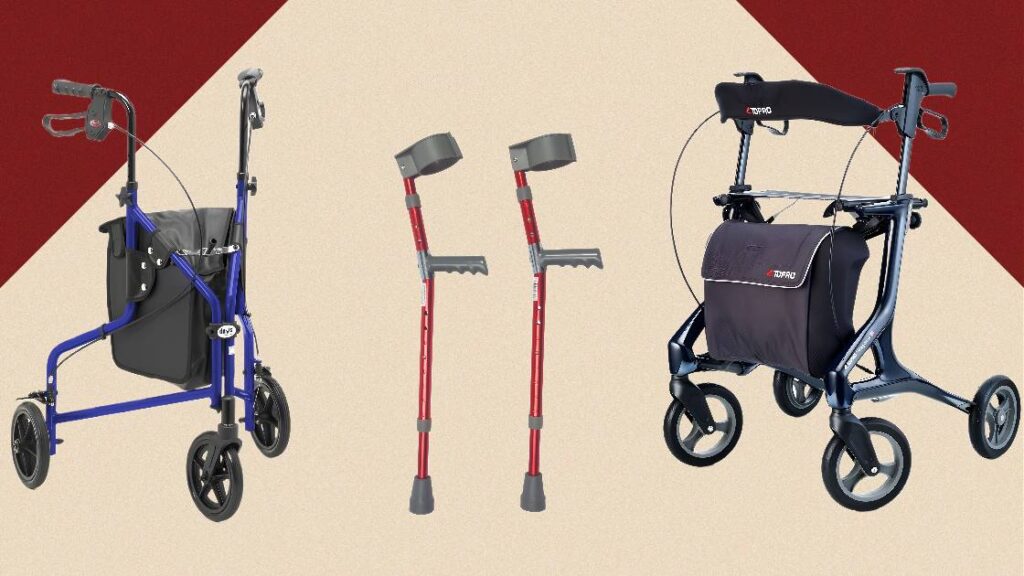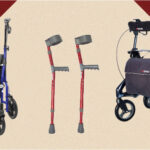
Introduction
If you have limited mobility, a walking aid can make it easier for you to get around and maintain your independence. Whether you're recovering from an injury or surgery, or simply need extra support and stability, there is a wide range of walking aids available to suit your needs. In this guide, we will discuss different types of walking aids, including rollators, tri-walkers, canes, folding canes, walking sticks, and crutches, as well as walking frames.
Table of Contents
Different types of walking aids
There are a variety of walking aids available, each with its own unique features and benefits. Canes, crutches, walking frames, tri-walker, walking sticks and rollators are the most common types of walking aids.
Rollator
A rollator is a type of walker that has wheels and a built-in seat. They come in different styles, including manual and electric assist. Manual rollators require the user to push themselves with the help of a lever or handlebar, while electric-assist rollators have an electric motor that helps the user push themselves forward when they lift their foot off the ground. Rollators are great for people who need extra support and stability while walking, and can also be used as a temporary or permanent mobility aid.
Choosing a Rollator
Choosing the right rollator can make a big difference in the mobility and independence of the user. When looking for a rollator, consider the following points:
- Weight capacity: Make sure the rollator can support the user's weight and any additional items they may carry.
- Width: Consider the width of the rollator to ensure it can fit through doorways and navigate tight spaces.
- Height: Look for a rollator that is adjustable to the user's height for comfortable use.
- Brakes: Check for both hand brakes and loop brakes for added safety and control.
- Wheel size: Larger wheels provide better stability and manoeuvrability on uneven surfaces.
- Foldability: Look for a rollator that can be easily folded for storage and transportation.
- Accessories: Some rollators come with extras like a basket or tray for carrying items. Consider if these features would be useful for the user.
Tri-Walker
A tri-walker is a three-wheeled walker that provides stability and support. It can be used as a temporary walker or as a permanent mobility aid. Tri-walkers are not recommended for long distances or uneven terrain because they do not provide enough stability to allow you to safely complete these tasks. To use a tri-walker, you must first remove one wheel from each side of the frame, which will make it easier for you to push yourself around. Then, place your feet on top of each wheel with the leg rest facing forward, so that when you stand up straight, there is no pressure on your knees.
Choosing a Tri Walker
When choosing a Tri Walker, it's important to consider the following:
- Weight capacity: Make sure the Tri Walker can support your weight and any additional items you may be carrying.
- Size and manoeuvrability: Consider the width of doorways and tight spaces you will be navigating through to ensure the Tri Walker can fit comfortably.
- Brakes: Look for a Tri Walker with secure and easy-to-use brakes for added safety.
- Adjustability: Make sure the handle height and seat can be adjusted to your comfort level.
- Storage: Consider if the Tri Walker has any storage options, such as a basket or bag, for your personal items.
- Additional features: Look for additional features that may be beneficial to you, such as a built-in seat or a foldable design for easy transport.
Walking Frame
A walking frame, also known as a walker or zimmer frame, is a mobility aid that provides support and stability for individuals who have difficulty walking. It typically consists of a frame with four legs and handgrips, allowing the user to hold onto the frame for support while walking. Some walking frames also have wheels attached to the front legs for ease of movement. They are designed to help individuals with conditions such as arthritis, Parkinson's disease, or recovering from a stroke or surgery.
Choosing a Walking Frame
When choosing a walking frame, it's important to consider several factors to ensure you get the right fit for your needs. Here are a few key points to keep in mind:
- Size and weight: Make sure the walking frame is the right size for you and that you're able to comfortably lift and manoeuvre it.
- Adjustability: Look for a walking frame that can be adjusted to the right height for you, as well as one that has the ability to change the distance between the handlebars.
- Stability: Consider the design and construction of the walking frame to ensure that it is stable and able to provide the support you need.
- Mobility: Consider the type of mobility you need, such as indoor or outdoor use, and choose a walking frame that is suitable for your needs
- Additional features: Some walking frames come with additional features such as a seat or storage pouch, which may be useful depending on your needs.
- Brand and warranty: Look for a reputable brand and a warranty that provides adequate protection for your purchase.
Canes
Canes are a popular choice for people with limited mobility. There are many different types of canes available, including those that help you walk or stand up from a seated position. Canes are generally made from wood, aluminium, and carbon fibre. The most common type of cane is the walking stick, which has an ergonomic handle to make it comfortable to hold while walking long distances.
Choosing a Cane
When choosing a cane, there are several important factors to consider:
- Material: Canes can be made from a variety of materials, including wood, aluminium, and carbon fibre. Each material has its own advantages and disadvantages, so it's important to choose one that best fits your needs.
- Size: Canes come in different sizes and it is important to find one that is the appropriate height for you. This will ensure that the cane is comfortable to use and provides the proper support.
- Weight: Some canes are lighter than others, which can be beneficial for people who have trouble lifting heavy objects.
- Handle: The handle of a cane can be made from a variety of materials, including wood, rubber, and foam. It's important to choose a handle that is comfortable to grip and easy to hold for extended periods of time.
- Additional features: Some canes may come with additional features such as a built-in seat, or a folding cane. Consider if you require any additional features before purchasing.
It is also important to consult with a healthcare professional before making a final decision on a cane, as they can help determine which type and size of cane are best for your needs.
Folding Canes
Folding canes are lightweight, easy to use, and portable. They are great for elderly people or disabled people who may not be able to walk far. Folding canes come in a variety of styles and make it easy to store them when not in use. Some folding canes even have handles that fold out, so they are ready to go when needed.
Choosing a Folding Cane
When choosing a folding cane, it is important to consider the following factors:
- Weight capacity: Make sure the cane can support your weight.
- Adjustability: Look for a cane that can be adjusted to your height.
- Handle: Consider the type of handle that is comfortable for you to hold.
- Material: Canes are made of various materials such as aluminium, wood, and carbon fibre. Each material has its own advantages and disadvantages.
- Tip: Look for a cane with a tip that provides good traction and stability.
- Folding mechanism: Make sure the folding mechanism is easy for you to use.
- Portability: Consider the size and weight of the cane when folded, as well as any carrying case or storage options that are available.
- Additional features: Some canes come with additional features such as built-in lights, LED lights, and hand grips.
It is important to try out different canes before purchasing to ensure the best fit for your needs. Additionally, consulting with your doctor or physical therapist can also help you determine the right type of cane for you.
Walking Stick
Walking sticks are a great way to improve your posture and provide balance when walking. They can also make it easier to get up from a seated position and provide stability for those who have difficulty standing on their own. Walking sticks offer extra support and improved balance, so they can help correct body positioning issues such as forward curvature or posterior tilting of the pelvis, which can contribute to chronic neck pain caused by poor posture.
Choosing a Walking Stick
When choosing a walking stick, there are a few important factors to consider:
- Material: Walking sticks can be made from a variety of materials, including wood, metal, and composite materials. Consider the weight, durability, and aesthetic of the stick when making your choice.
- Size: Make sure the stick is the right size for you by standing up straight and having the stick reach the ground about an inch or two in front of your toes.
- Grip: The grip should be comfortable and easy to hold. You may want to try a few different types of grips, such as a foam or rubber grip, to see which one works best for you.
- Additional features: Some walking sticks come with additional features, such as a built-in seat or a light. Consider if these features will be useful to you.
- Price: Different walking sticks can vary greatly in price, so it's important to consider your budget when making your choice.
Crutches
Crutches are a great way to get around, but you need to be careful with how you use them. Crutches are often used for short distances and in an upright position. They are not ideal for long distances or when walking with your knees bent, as this can cause back strain and fatigue. There are many different types of crutches available, including standard, folding/straight-legged, and ergonomic. The most important thing is to choose a crutch with a wide base that won't slip.
Choosing a Crutch
When choosing crutches, it's important to consider the following:
- Type of crutches: There are different types of crutches available, including axillary crutches, underarm crutches, and forearm crutches. Each type has its own set of benefits and drawbacks, so it's important to consider which type will work best for you.
- Adjustability: Make sure that the crutches are adjustable to your height and weight, this will help to prevent any injuries.
- Grip: The grip of the crutches should be comfortable and secure. Look for crutches with cushioned handles and a non-slip surface.
- Weight capacity: Check the weight capacity of the crutches and make sure they can support your weight.
- Durability: Crutches are an investment, so it's important to choose a pair that is made of high-quality materials and built to last.
- Folding or non-folding: Folding crutches are convenient and easy to transport, while non-folding crutches tend to be sturdier.
- Keep in mind your condition: Some crutches may be suitable for specific conditions, such as underarm crutches for people recovering from a broken leg.
Conclusion
In conclusion, choosing the right walking aid can be a daunting task, but it doesn't have to be. Our Mobility Shop Walking Aids category offers a wide range of options to fit your specific needs and budget. From simple canes to advanced rollators and walking frames, we have something for everyone. Browse our selection today and take the first step towards improving your mobility.

